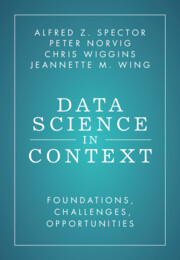Book contents
- Data Science in Context
- Reviews
- Data Science in Context
- Copyright page
- Contents
- Figures
- Tables
- Preface
- Acknowledgments
- Introduction
- Part I Data Science
- Part II Applying Data Science
- Chapter 4 Data Science Applications: Six Examples
- Chapter 5 The Analysis Rubric
- Chapter 6 Applying the Analysis Rubric
- Chapter 7 A Principlist Approach to Ethical Considerations
- Recap of Part II: Applying Data Science
- Part III Challenges in Applying Data Science
- Part IV Addressing Concerns
- Chapter 20 Concluding Thoughts
- Appendix Summary of Recommendations from Part IV
- About the Authors
- References
- Index
Chapter 5 - The Analysis Rubric
from Part II - Applying Data Science
Published online by Cambridge University Press: 29 September 2022
- Data Science in Context
- Reviews
- Data Science in Context
- Copyright page
- Contents
- Figures
- Tables
- Preface
- Acknowledgments
- Introduction
- Part I Data Science
- Part II Applying Data Science
- Chapter 4 Data Science Applications: Six Examples
- Chapter 5 The Analysis Rubric
- Chapter 6 Applying the Analysis Rubric
- Chapter 7 A Principlist Approach to Ethical Considerations
- Recap of Part II: Applying Data Science
- Part III Challenges in Applying Data Science
- Part IV Addressing Concerns
- Chapter 20 Concluding Thoughts
- Appendix Summary of Recommendations from Part IV
- About the Authors
- References
- Index
Summary
This chapter uses the learnings from Chapter 4’s examples to create the Analysis Rubric, which consists of seven major considerations for determining data science’s applicability to a proposed application. While these considerations may not be fully understood at a project’s inception, there needs to be a belief that answers will be forthcoming prior to completion. Three of these address requirements-oriented aspects (“For What or Why”) of data science applications, and three address implementation-oriented aspects (“How To”). The seventh addresses legal, societal, and ethical implications (ELSI). Collectively, these considerations, or Analysis Rubric elements, cover the complex trade-offs needed to achieve practical, valuable, legal, and ethical results. The chapter concludes by applying the Analysis Rubric to the previous chapter’s examples.
Information
- Type
- Chapter
- Information
- Data Science in ContextFoundations, Challenges, Opportunities, pp. 61 - 73Publisher: Cambridge University PressPrint publication year: 2022
